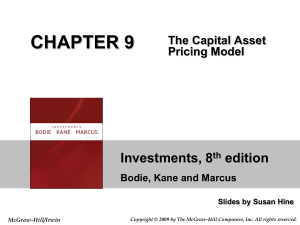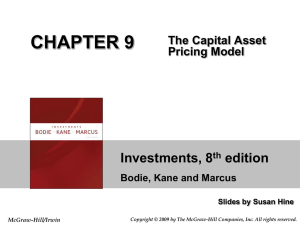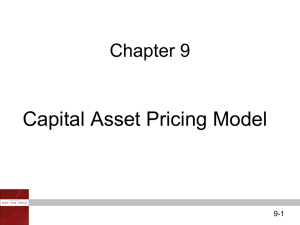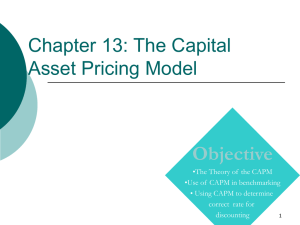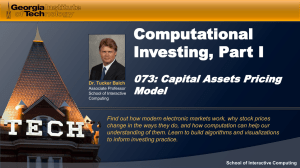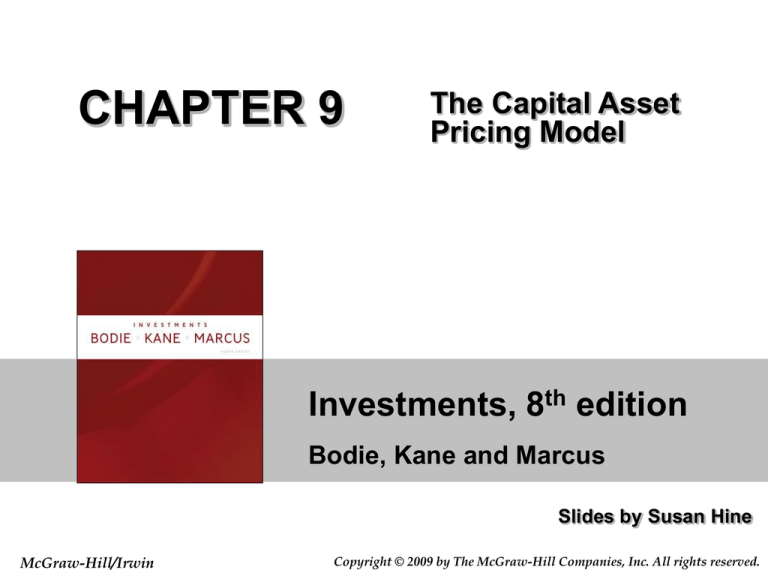
CHAPTER 9
The Capital Asset
Pricing Model
Investments, 8th edition
Bodie, Kane and Marcus
Slides by Susan Hine
McGraw-Hill/Irwin
Copyright © 2009 by The McGraw-Hill Companies, Inc. All rights reserved.
Capital Asset Pricing Model (CAPM)
• It is the equilibrium model that underlies all
modern financial theory
• Derived using principles of diversification with
simplified assumptions
• Markowitz, Sharpe, Lintner and Mossin are
researchers credited with its development
9-2
Assumptions
• Individual investors are price takers
• Single-period investment horizon
• Investments are limited to traded financial
assets
• No taxes and transaction costs
9-3
Assumptions Continued
• Information is costless and available to all
investors
• Investors are rational mean-variance
optimizers
• There are homogeneous expectations
9-4
Resulting Equilibrium Conditions
• All investors will hold the same portfolio for
risky assets – market portfolio
• Market portfolio contains all securities and
the proportion of each security is its market
value as a percentage of total market value
9-5
Resulting Equilibrium Conditions
Continued
• Risk premium on the market depends on the
average risk aversion of all market
participants
• Risk premium on an individual security is a
function of its covariance with the market
9-6
Figure 9.1 The Efficient Frontier and the
Capital Market Line
9-7
Market Risk Premium
•The risk premium on the market portfolio will
be proportional to its risk and the degree of risk
aversion of the investor:
E (rM ) rf A M
2
where
2
M
is the variance of the market portolio and
A is the average degree of risk aversion across investors
9-8
Return and Risk For Individual Securities
• The risk premium on individual securities is a
function of the individual security’s
contribution to the risk of the market portfolio
• An individual security’s risk premium is a
function of the covariance of returns with the
assets that make up the market portfolio
9-9
Using GE Text Example
• Covariance of GE return with the market
portfolio:
n
n
Cov(rGE , rM ) Cov rGE , wk rk wk Cov(rk , rGE )
k 1
k 1
• Therefore, the reward-to-risk ratio for
investments in GE would be:
GE's contribution to risk premium
GE's contribution to variance
wGE E (rGE ) rf
E (rGE ) rf
wGE Cov(rGE , rM )
Cov(rGE , rM )
9-10
Using GE Text Example Continued
• Reward-to-risk ratio for investment in
market portfolio:
Market risk premium
E (rM ) rf
M
2
Market variance
• Reward-to-risk ratios of GE and the market
portfolio:
E (rGE ) rf
E (rM ( rf )
Cov(rGE , rM )
M2
• And the risk premium for GE:
E (rGE ) rf
Cov(rGE , rM )
2
M
E (rM ) rf
9-11
Expected Return-Beta Relationship
• CAPM holds for the overall portfolio because:
E (rP ) wk E (rk ) and
k
P wk k
k
• This also holds for the market portfolio:
E (rM ) rf M E (rM ) rf
9-12
Figure 9.2 The Security Market Line
9-13
Figure 9.3 The SML and a Positive-Alpha
Stock
9-14
The Index Model and Realized Returns
• To move from expected to realized returns—
use the index model in excess return form:
Ri i i RM ei
• The index model beta coefficient turns out to
be the same beta as that of the CAPM
expected return-beta relationship
9-15
Figure 9.4 Estimates of Individual Mutual
Fund Alphas, 1972-1991
9-16
The CAPM and Reality
• Is the condition of zero alphas for all stocks
as implied by the CAPM met
– Not perfect but one of the best available
• Is the CAPM testable
– Proxies must be used for the market
portfolio
• CAPM is still considered the best available
description of security pricing and is widely
accepted
9-17
Econometrics and the Expected ReturnBeta Relationship
• It is important to consider the econometric
technique used for the model estimated
• Statistical bias is easily introduced
– Miller and Scholes paper demonstrated
how econometric problems could lead one
to reject the CAPM even if it were perfectly
valid
9-18
Extensions of the CAPM
• Zero-Beta Model
– Helps to explain positive alphas on low
beta stocks and negative alphas on high
beta stocks
• Consideration of labor income and nontraded assets
• Merton’s Multiperiod Model and hedge
portfolios
– Incorporation of the effects of changes in
the real rate of interest and inflation
9-19
Extensions of the CAPM Continued
• A consumption-based CAPM
– Models by Rubinstein, Lucas, and Breeden
• Investor must allocate current wealth between
today’s consumption and investment for the future
9-20
Liquidity and the CAPM
• Liquidity
• Illiquidity Premium
• Research supports a premium for illiquidity.
– Amihud and Mendelson
– Acharya and Pedersen
9-21
Figure 9.5 The Relationship Between
Illiquidity and Average Returns
9-22
Three Elements of Liquidity
• Sensitivity of security’s illiquidity to market
illiquidity: Cov(C , C )
i
L1
M
Var ( RM CM )
• Sensitivity of stock’s return to market
illiquidity: Cov( R , C )
i
L2
M
Var ( RM CM )
• Sensitivity of the security illiquidity to the
market rate of return:
L3
Cov(Ci , RM )
Var ( RM CM )
9-23

